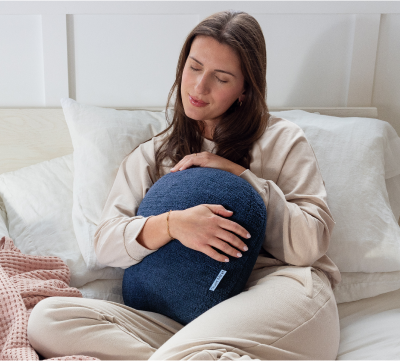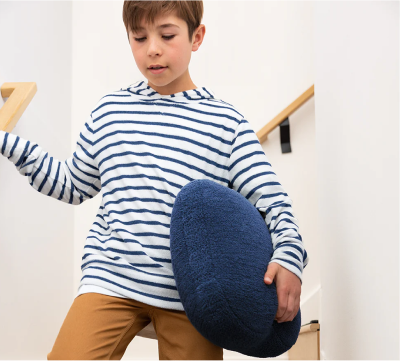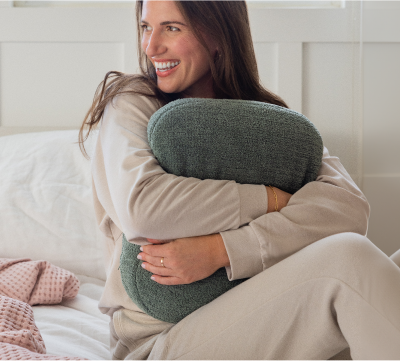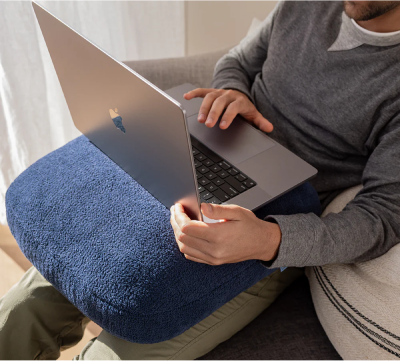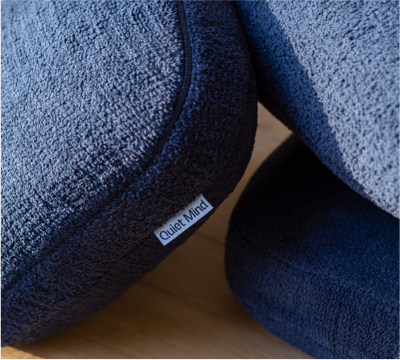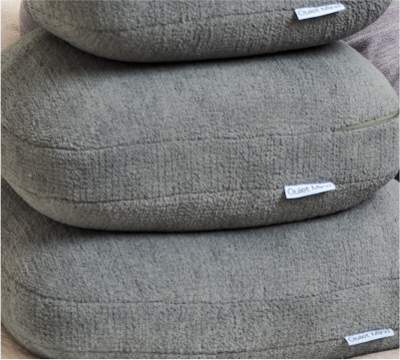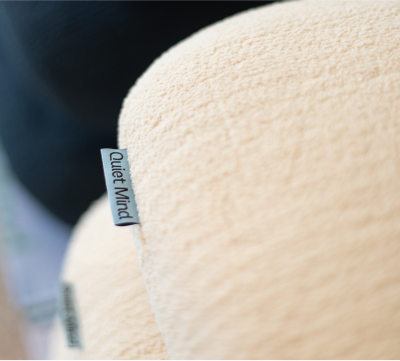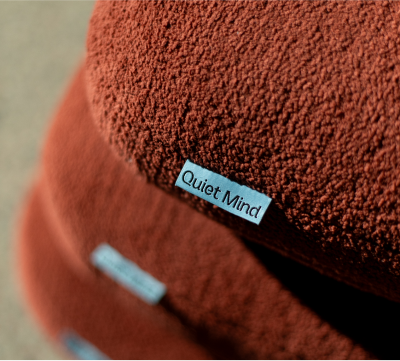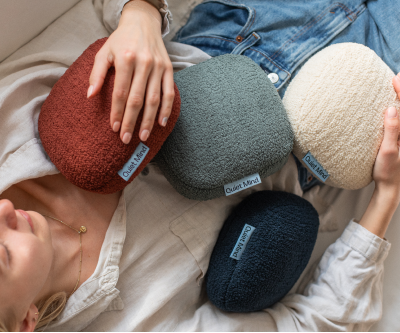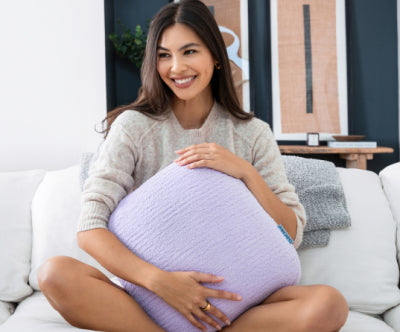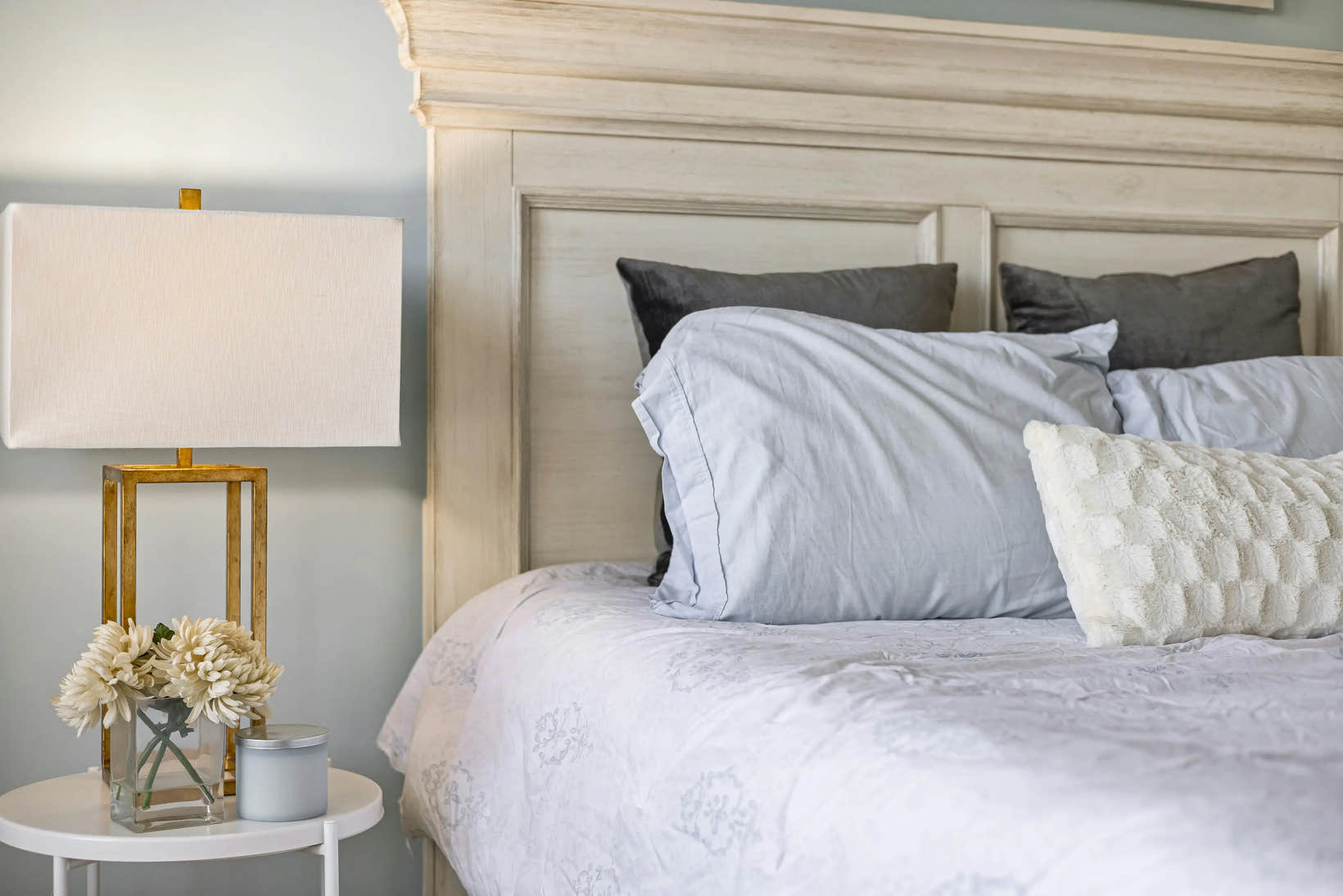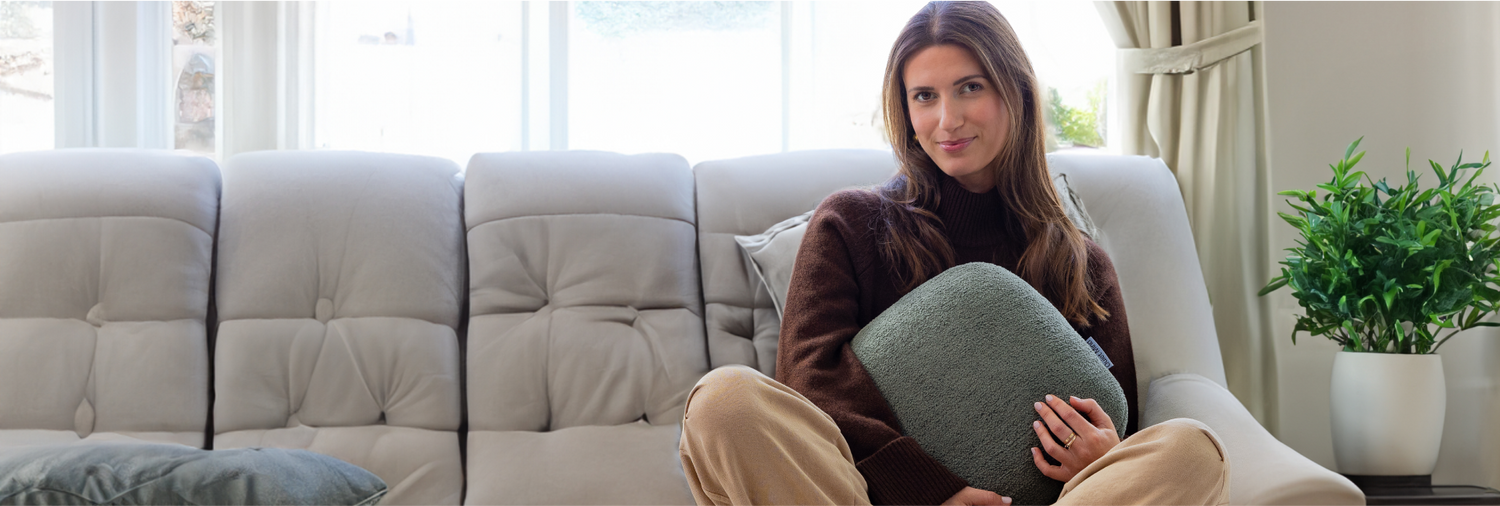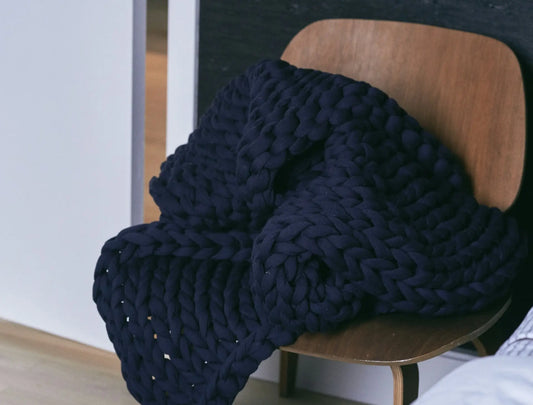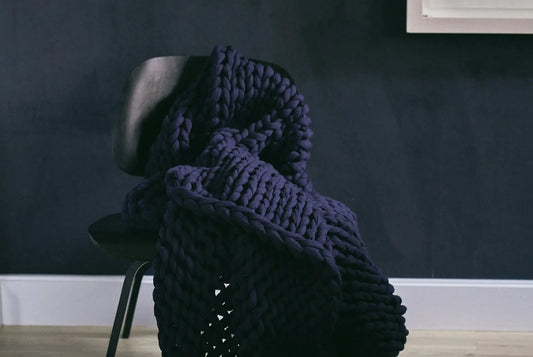Sometimes, rest feels just out of reach. Your thoughts move too quickly, your body won’t settle. In these moments, stillness can begin with something simple, added weight. Gentle, grounding, and quiet.
A weighted pillow isn’t just about comfort. It’s a supportive tool for nervous system regulation, offering deep pressure therapy that speaks to the body’s innate need for safety and calm. Much like a weighted blanket, it applies gentle pressure to help reduce stress, ease tension, and calm the mind.
When used with intention, it becomes part of a deeper ritual of care, one that helps alleviate anxiety, promote restful sleep, and create a sense of focused calm.
In this guide, you’ll learn how a weighted pillow can help support relaxation, how to use a weighted pillow effectively, and how to make it a comforting part of your daily wellness routine.
What Is a Weighted Pillow and How Does It Work?
A weighted pillow is designed to apply gentle pressure across the body, similar to a firm hug or a warm embrace. This effect is known as deep pressure stimulation, a form of tactile input that helps guide the nervous system from a state of fight or flight to rest and digest.
Weighted pillows provide sensory feedback that may:
- Lower cortisol levels (the body’s stress hormone).
- Support the release of calming neurotransmitters like serotonin and dopamine.
- Enhance melatonin production to improve sleep onset.
- Shift the body into a parasympathetic (relaxation) state.
The science behind weighted tools like these supports the use of weight for stress management, sensory support, and emotional regulation. Just as people use weighted blankets for full-body grounding, the benefits of a weighted pillow are especially accessible for targeted relief whether at your desk, in bed, or during meditation.
How to Use a Weighted Pillow for Anxiety and Stress Relief
A weighted pillow can help bring your body and mind back to center when you're feeling overstimulated, anxious, or emotionally flooded. It works like a tactile anchor, redirecting your nervous system and providing the calming effect of deep pressure therapy.
Placing It on the Chest or Lap During Rest or Meditation
The chest and lap are powerful regulation zones. Placing a weighted pillow on these areas helps the body relax, signals to the brain that it's safe, and slows the heart rate through parasympathetic activation.
To try this practice:
- Sit or lie in a supported position and use a cushion behind your back or head.
- Rest the pillow gently across your chest or in your lap.
- Let your hands interact with the texture like a stress ball, if tactile input helps.
- Close your eyes and breathe deeply, focusing on the pressure and the movement of your breath.
This technique can be used before meditation, during breathwork, or when you simply need a pause.
Holding It During Overwhelm or Emotional Regulation
During a surge of emotion; such as grief, panic, or sensory overload, a weighted pillow acts like a hug. Holding it close delivers the sense of proprioception and comforting touch that brings the nervous system back into balance because of the deep touch pressure.
Try this method when:
- You feel anxious in social settings or before a challenging conversation.
- You're experiencing emotional dysregulation or unexpected tears.
- You're navigating trauma memories, sensory overwhelm, or burnout.
Wrap your arms around the pillow and gently press it into your chest or abdomen. This soft pressure can feel incredibly stabilizing and soothing and a squeeze of weight when the world feels too much.
Other Supportive Uses
- During therapy sessions (virtual or in-person) for grounding.
- While journaling or processing thoughts.
- At work or school when emotions spike and focus fades.
- After overstimulating events, like crowded spaces or noisy environments.
Regular use may help the body form a routine response, learning to associate the weighted pillow with a return to calm and focus.
How to Use a Weighted Pillow While Working
Using a weighted pillow during work hours can be a subtle but powerful way to support focus, emotional regulation, and physical ease, especially for those with ADHD, anxiety, or sensory needs. Whether you're working at a desk, studying, or doing creative tasks, the pillow acts as a grounding tool that supports stillness without forcing it.
Here’s how to use it effectively during work:
-
Place it on your lap while seated: This creates gentle tactile feedback that can reduce fidgeting, support posture, and increase body awareness, similar to how some people use stress balls or fidget tools.
-
Use during transitions or reset moments: Holding the pillow briefly between tasks, during breaks, or after a challenging interaction can help you self-regulate and return to a calmer, more focused state.
- Incorporate into sensory-friendly workspaces: Pair the weighted pillow with other calming tools like noise-canceling headphones, soft lighting, or aromatherapy. This multi-sensory support can reduce overwhelm and support sustained attention.
Weighted pillows offer a non-disruptive way to stay grounded in environments that can otherwise be overstimulating or emotionally taxing. They’re especially helpful during virtual meetings, deep work sessions, or any time you feel yourself disconnecting from your body or focus.
How to Use a Weighted Pillow for Better Sleep?
The transition to sleep can be turbulent especially when stress or overstimulation is present. A weighted pillow offers a calming sleep cue, signaling the brain and body that it’s time to relax and release. Many people wonder if weighted pillows are good for them, especially when integrating these products into a nighttime routine.
Where to Place It: Chest, Neck, or Alongside You
Depending on your sleep preferences, you can use your weighted pillow in several ways:
- On the chest: Creates a sense of calm, lowers the heart rate, and grounds the breath.
- Behind the neck: Supports the cervical spine, eases muscle tension, and helps you settle.
- Beside you: Mimics the sensation of a cuddle, offering emotional comfort without restricting movement.
- Across the hips or thighs: Provides lower body pressure for those who feel tension in the legs.
Use it alone or pair it with a weighted blanket for full-body support. Together, weighted pillows and weighted blankets can transform your sleep into a more sensory-integrated experience.
Pairing with Breathing Exercises or Nighttime Routines
To truly enhance the benefits of a weighted pillow, incorporate it into a multi-sensory bedtime ritual. This may include:
- 4-4-4-4 breathing (inhale for 4, hold for 4, exhale for 4, pause for 4).
- Guided meditations, body scans, or sleep-focused affirmations.
- Aromatherapy using calming oils like lavender or cedarwood.
- Warm lighting, screen-free time, and soft ambient sounds.
These rituals don’t just help you fall asleep faster, they reinforce the body’s association of bedtime with safety and comfort, leading to a stronger sense of relaxation over time.
Additional Tips for Sleep Support
- Place your original weighted pillow over your midsection during nighttime awakenings.
- Use it with a body pillow for full-side support if you’re a side sleeper.
- Choose a pillow with recycled glass beads or evenly distributed bead fill for a smoother feel.
What Are the Best Weighted Pillow Positions and Placements for Maximum Comfort?
There’s no single way to use a weighted pillow and that’s part of its strength. Its flexibility allows you to respond to what your body and mind need in the moment. Whether you’re looking to reduce stress, increase focus and attention, or encourage sleep and relaxation, there’s a position that can help you feel more grounded.
Common Weighted Pillow Positions and When to Use Them
These common positions show how a weighted pillow can support different moments of your day, whether you're seeking focus, rest, or emotional grounding.
|
Position |
Benefits |
Tips for Use |
|
Sitting |
Lap pressure for grounding, clarity, and motivation and focus |
Use during meditation, reading, journaling, or quiet breaks to stay present |
|
Lying Down |
Emotional release and restful sleep |
Place across your chest, along your legs, or beside you for a calming effect |
|
Desk Use |
Sensory regulation and postural support |
Use on your lap while working or studying to minimize fidgeting or restlessness |
|
On the Neck or Shoulders |
Eases tension, encourages alignment |
Ideal after long screen time or travel; choose a curved or ergonomic shape |
|
Across the Hips or Thighs |
Lowers energy and helps unwind |
Particularly helpful for those with restless legs or postural fatigue |
|
As a Bedside Cuddle Tool |
Adds a soothing sense of presence |
Place it beside you like a weighted body pillow for emotional reassurance |
These placements are not fixed. You can rotate between them throughout your day or week. The key is to observe what position brings the most comfort, like a hug that your nervous system can trust.
For example, if you’re using a quiet mind weighted pillow during work hours, the lap position offers deep pressure therapy to help regulate your nervous system without interrupting your flow. At night, lying down with the pillow across your torso can support a sense of relaxation and signal that it’s time to shift into rest and digest mode.
Ideal Pillow Weight and Size for Different Scenarios
Choosing the right weight and size for your weighted pillow can significantly enhance its effectiveness. The right amount of added weight creates a balance between gentle pressure and comfort, promoting the release of calming and focusing hormones like serotonin and dopamine.
The filling material of weighted pillows also plays a key role, fill types like glass beads, poly pellets, or natural grains can affect texture, weight distribution, and overall feel. The wrong size, heaviness, or material, however, can feel stifling or awkward, interfering with the benefits of a weighted pillow.
Recommended Weights by Scenario
If you're unsure how heavy a weighted pillow should be, these recommendations can help guide your choice.
|
Scenario |
Ideal Weight Range |
Considerations |
|
Sleeping |
10–15% of body weight |
Choose a size that covers the torso and encourages restful sleep |
|
Desk or Sitting Use |
5–10% of body weight |
Use a slightly lighter pillow to allow movement and extended use |
|
Sensory-Sensitive Adults |
1–2 lbs to start |
Always begin light, observe comfort, and consult professionals if needed |
|
Travel or On-the-Go Use |
Under 3 lbs |
Choose a compact, machine washable model with portable filling |
|
Full-Body Application |
5–8 lbs, elongated shape |
Use like a weighted body pillow across multiple zones for grounding |
Weighted pillows provide different sensations depending on the type of fill. Recycled glass beads are a popular option because they offer smooth texture, quiet distribution, and eco-conscious benefits. These beads distribute weight evenly across the pillow’s surface, helping generate a balanced, body-safe sense of proprioception.
How Often Should You Use a Weighted Pillow?
There’s no rigid schedule for using a weighted pillow. Its frequency and function depend on your personal rhythm, sensory needs, and how your body responds to deep pressure therapy. Some people incorporate it into their daily wellness habits, while others reach for it only during high-stress situations.
Daily Use for Routine Calm and Sensory Support
Using your weighted pillow daily can help build a calming routine that your body comes to recognize. This type of regular exposure helps regulate the nervous system and supports a shift from fight or flight to rest and digest, especially when paired with consistent cues like breathwork or a quiet space.
Here’s when you can integrate the weighted pillow in your daily routine:
|
When |
Why it helps |
|
During meditation |
Enhances stillness, promotes focus and attention, and anchors breath |
|
At bedtime |
Signals the body to shift toward restful sleep and prepares for sleep and relaxation |
|
During rest breaks |
Acts like a stress ball, reducing stress and anxiety during overstimulation |
Adding a weighted cuddle pillow to your daily routine helps establish a sense of calm that becomes easier to access over time.
Occasional Use for Travel or High-Stress Moments
Even if you don’t use your original weighted pillow daily, it’s an excellent tool for transitional or emotionally intense moments. It provides a portable form of deep pressure stimulation that helps you stay grounded in unfamiliar or heightened environments.
Try it during:
- Airplane, train, or car rides.
- Before interviews or presentations.
- Family gatherings or emotionally charged events.
- Stressful commutes or loud public places.
Compact pillows filled with recycled glass beads are ideal for travel; they're lightweight, discreet, and often machine washable for easy care.
Tips for Getting the Most Out of Your Weighted Pillow
Even small changes can elevate the benefits of a weighted pillow. Here’s how to make your experience more restorative and tailored to your body’s needs.
Using It with Aromatherapy or Meditation Tools
Combining sensory inputs like gentle pressure, scent, sound, and breath can strengthen the brain’s ability to shift into parasympathetic mode. This multi-sensory approach supports the release of calming and focusing hormones, including dopamine, and makes relaxation easier to access.
Enhancement ideas:
- Diffuse essential oils like lavender or cedarwood nearby.
- Use a Quiet Mind weighted pillow cover with scent infusion.
- Pair with soft ambient music, white noise, or guided meditation apps.
- Try before or after yoga or body and mind movement practices.
Together, these elements create a soothing environment for restoration.
Maintaining Posture and Preventing Strain
How you position your body while using your pillow affects both comfort and effectiveness. Because weighted pillows provide tactile input, they should not create tension or misalignment.
Postural tips:
- Keep your spine supported while sitting, lying down, or reclining.
- Avoid craning your neck if placing the pillow behind the head.
- Sit upright with shoulders relaxed when using it in your lap.
- Shift positions every 20–30 minutes to promote circulation.
Creating a Consistent Routine for Emotional Safety
The nervous system responds well to repetition and routine. Using your weighted pillow at similar times or during specific transitions can help your body associate it with relief and grounding. This builds emotional safety over time.
Routine-building ideas:
- Add it to your bedtime wind-down with tea, quiet music, or journaling.
- Use it after overstimulating events to create a sense of recovery.
- Keep it in a familiar spot so the visual presence reinforces calm.
A consistent sensory routine helps turn the pillow into a trusted support tool.
Using It During Transitions or Emotional Swells
Weighted pillows are especially helpful during emotional shifts—before meetings, after arguments, or during moments of overwhelm. They help the body return to center when energy feels scattered or dysregulated.
How to use in transitional moments:
- Hold it briefly while shifting from work to rest.
- Place it on your chest or lap before a challenging conversation.
- Use it to recenter after a social event or overstimulating task.
This simple tactile cue can help reset your focus and support emotional balance.
Remember, the goal of all weighted products is ease and not effort.
Common Mistakes to Avoid When Using a Weighted Pillow
Even a calming tool like a weighted pillow can feel uncomfortable if used improperly. Here are common missteps to be aware of, and how to fix them:
- Using a pillow that’s too heavy: Excess added weight can cause muscle strain or trigger discomfort, especially in children or those with chronic tension.
- Blocking airflow while sleeping: Avoid placing pillows directly over the face or neck in ways that may restrict breath. Always ensure open, relaxed positioning.
- Overusing it without movement: Sitting too long without shifting posture, even with a weighted pillow, may lead to stiffness. Alternate placement or take stretch breaks.
- Expecting instant results: It may take several uses before your body begins to associate the pillow with safety and relaxation. Be patient, just like with a weighted blanket, benefits often build gradually.
Used thoughtfully, a weighted pillow can help regulate stress, improve focus, and offer a comforting sense of touch that your body craves.
Who Should Not Use a Weighted Pillow?
While weighted pillows can provide comfort and sensory regulation for many people, they are not suitable for everyone. Certain health conditions or sensitivities can affect how the body responds to deep pressure.
If you or your child fall into any of the following categories, it's important to speak with a healthcare provider before use:
-
Respiratory conditions: Even light pressure on the chest or neck may restrict airflow or disrupt breathing, especially during rest.
-
Circulatory issues: Added weight could interfere with circulation, particularly if numbness or coldness is already present in the limbs.
-
Chronic pain or musculoskeletal sensitivities: Conditions like fibromyalgia or joint pain may increase sensitivity to touch, making pressure uncomfortable rather than calming.
- Sensory processing challenges: While some neurodivergent individuals benefit from deep pressure input, others may feel overstimulated or overwhelmed by it. It’s best to introduce any weighted item gradually, with supervision and consent.
Always choose a weight that feels grounding, not restrictive, and monitor for signs of discomfort, tension, or emotional distress. A weighted pillow should offer relief, not pressure your system beyond what feels safe.
Final Thoughts: Making Weighted Pillows Part of Your Wellness Routine
A weighted pillow isn’t just for stress, it’s a reminder to pause, breathe, and return to the present. By applying gentle pressure that feels like a hug, it taps into the body’s natural ability to self-regulate.
Whether you're looking to reduce anxiety, ease into restful sleep, or find clarity during the day, this simple tool invites your nervous system to shift from fight or flight to rest and digest.
Use it during transitions, emotional moments, or as part of your evening wind-down. Over time, your body begins to associate that steady sense of calm with safety and restoration. Pair it with your favorite scents, sounds, or rituals to deepen its effects.
Let it be your anchor, a quiet way to soothe your body and mind, one breath at a time.
About Quiet Mind
Quiet Mind creates sensory wellness tools designed to support calm, presence, and emotional balance. We specialize in products that use deep pressure therapy, such as our signature Quiet Mind Weighted Pillow, thoughtfully crafted with recycled glass beads, soft finishes, and machine washable covers for daily ease and comfort.
Our mission is to offer tools that feel like care, backed by the science behind weighted support and inspired by the real needs of people navigating stress and anxiety, sensory sensitivity, and nervous system overwhelm. From the weighted cuddle pillow to supportive sleep routines, our designs help shift your system from fight or flight to rest and digest with every gentle squeeze.
At Quiet Mind, we believe regulation starts with softness. Our products meet you where you are offering grounding, stillness, and comfort when you need it most.
Frequently Asked Questions
What is a weighted pillow and how does it work?
A weighted pillow uses deep pressure stimulation to calm the nervous system. It can increase serotonin and melatonin while reducing cortisol, promoting better mood and sleep.
How do I choose the right weighted pillow for my needs?
Consider your body size, sensitivity, and intended use. Start with 10–15% of your body weight for sleep, and go lighter for lap or desk use.
How often should I use my weighted pillow?
You can use it daily as part of a rest routine or occasionally during stressful times. Listen to your body and adjust based on what feels most supportive.
Can I use a weighted pillow with other relaxation techniques?
Yes. Weighted pillows work well alongside aromatherapy, meditation, deep breathing, and mindful movement.
How do I care for and maintain my weighted pillow?
Use a washable cover and spot clean the insert as needed. Fluff gently to redistribute the weight. Follow product-specific care instructions.
Can weighted pillows be used by individuals with sensory processing issues?
Yes. They can provide calming sensory input. Begin with a lighter weight and consult with an occupational therapist if needed.
Are weighted pillows suitable for children and pets?
They can be but should be chosen carefully. Use lighter weights and consult with a pediatrician or veterinarian before introducing one.
How long does it take to feel the benefits of using a weighted pillow?
Some people feel immediate calm. For others, the benefits build over time with regular use. Be patient and consistent.
